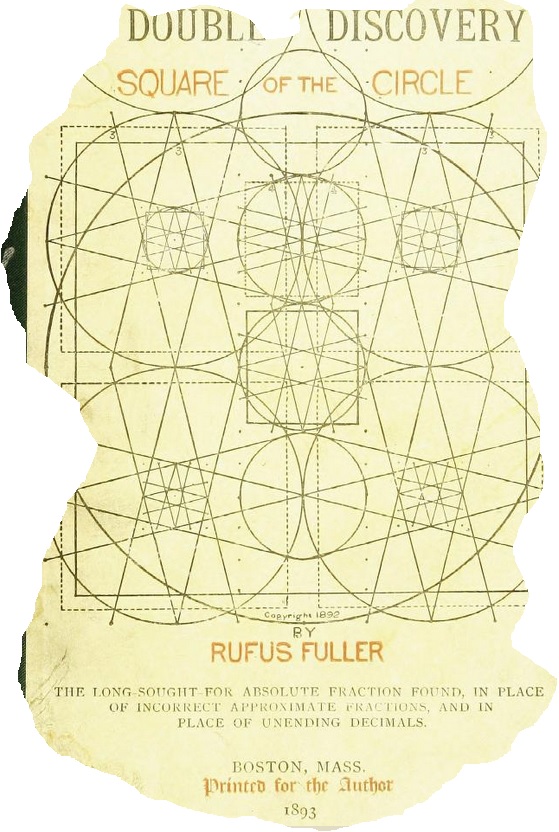
"Unlettered, Unschooled, or Wild"
Ernst Mach's Inventors I Have Met
2013 September 30

Dealing with the public, and more specifically with members of the public who hold strong but unorthodox opinions, has been an issue for most high-visibility scientists since the Industrial Revolution or earlier. Some scientists, jealous of their time, ignore "cranks" entirely, and it is hard to criticise them for this. The mathematician John Baez once proposed "a simple method for rating potentially revolutionary contributions to physics" contained in unsolicited manuscripts sent to well-known scientists by members of the public. Baez's "Crackpot Scale" goes from "1 point for every statement that is widely agreed on to be false" up to "40 points for comparing yourself to Galileo, suggesting that a modern-day Inquisition is hard at work on your case, and so on; 50 points for claiming you have a revolutionary theory but giving no concrete testable predictions." Few indeed are the outsider manuscripts with a low Baez number!
Few, but not zero; that is the problem, and most of the best physicists have always recognised it. James Glanz wrote a New York Times column in 2000 expressing his surprise that "[s]cientists, even those with [1997 Nobelist] Dr. Chu's high-powered credentials, display a willingness to engage the woolliest of theorists more often than might be believed." Glanz suggests that "[t]he reasons vary, ranging from fear of insulting someone who does not seem quite stable to tolerance of a scientist who, outside of a single, inexplicable obsession, does solid work"; it may also be because of the possibility, however slight, that the "crackpot" is no crackpot at all.
Albert Einstein, who probably received more unsolicited correspondence than any physicist before him, is said to have patiently answered every letter sent to him. Ernst Mach --- Einstein's inspiration in so many ways --- apparently had a similar attitude ...

INVENTORS I HAVE MET
by Ernst Mach.
Translated from the German by Lydia G. Robinson.
[Monist 22, 230 (1912)]
Mach's words are in bold.
ANY one who has been a professor of physics in a large city for several decades, unless he has earned a reputation for the crudest and densest Philistinism, must have made the acquaintance of divers thinkers and inventors who have taken counsel with him in their perplexities --- thinkers of all kinds, schooled and unschooled, sanguine and timid, those that solve problems and those that create them; thinkers, suspicious and confiding, ambitious and practical ; inventors at any price, and inventors on occasion.
It is obvious that the number of actual or alleged inventors in this company is greater than that of silent studious, self-centered thinkers. Practical discomfort is felt more often and to a greater extent than the rarer purely intellectual discomfort which is the heritage of men on a higher spiritual plane. Many fruitless hours may be spent in such consultations, but many a bit of psychological illumination may be gained and many a glance into the embryology of technique and science. We may add right here that the unlettered, unschooled or wild thinkers and inventors are the most interesting and instructive.

One day a gentleman was announced who had something of importance to communicate to me. He told me that he had taken a narrow tube full of liquid, closed at the upper end and open below, from which of course nothing could flow because of the pressure of air; then he gave it a charge of electricity, whereupon the liquid began at once to flow. From this he drew the rash conclusion that the electric charge removed the air pressure.
I gave instructions that an appointment be made with this gentleman for a free hour in the afternoon in order to make the experiment. But since one can easily tell whether or not a man is undertaking something from a purely theoretical interest, I said to the attendant in the laboratory, "The gentleman probably thinks he can drive a railway train with the electrical machine."
In the afternoon considerably before the appointed time the stranger put in an appearance. "Are you thinking of driving a railroad train ?" the attendant asked him by way of filling the interval with conversation. Immediately and without losing another word the gentleman seized his hat and was gone forever. So I had guessed his purpose correctly, and had deprived him of the pleasure of taking me into his confidence in his alleged lucrative undertaking. Forty years have passed since then, and the man has probably calmed down in the meantime.
[The effect which the "gentleman" had rediscovered was presumably electro-osmosis, now thought to be caused by the motion of the Debye layer of mobile ions along the tube-liquid interface. Electro-osmosis had been studied by F. F. Reuss in the early 1800s, and was a subject of serious research throughout the Nineteenth Century; it has become so again with the rise of microfluidics.]

There are people who become greatly excited over every scientific novelty, whose imagination busies itself at once in a new field without any special participation on the part of their intelligence, and whose desire it is to make an invention or a discovery in this field at any cost. So after the discovery of the Foucault rotation of the pendulum's plane of oscillation many experiments were made known by which it was thought this rotation could be perceived in water standing in a cylindrical tub across whose surface coal-dust had been lightly strewn ; or again in a horizontal disk suspended by a thread, or in a scale-beam similarly suspended.
But obviously these experiments are not sensible. For instance, if a horizontal disk is actually at rest with reference to the earth it has of course the component of rotation of the earth around the perpendicular corresponding to geographical latitude ; therefore the disk can not henceforth alter its position with reference to its terrestrial surroundings. Under other circumstances, however, it has an angular velocity around the perpendicular due to some impulse, to a draft of air, or the thread's momentum of rotation, and hence has no connection whatever to the Foucault rotation.
One young man could not accept these reflections at all but persisted in repeating the experiment thus described --- by which he gained the interest of an old gentleman who observed in them "sometimes" the genuine Foucault rotation.

To be sure, Professor Tumlirz has recently performed an experiment which, while externally similar to this, is correct. By this experiment the rotation of the earth can be imitated, if the utmost care is taken, by the direction of the current of water flowing axially out of a cylindrical vessel. Further details are to be found in an article by Tumlirz in the Sitzungsberichte der Wiener Akademie, Vol. 117, 1908. I happened to know the origin of the thought that gave rise to this invention. Tumlirz noticed that the water flowing somewhat unsymmetrically in a glass funnel assumed a swift rotation in the neck of the funnel so that it formed a whirl of air in the axis of the flowing jet. This put it in his mind to increase the slight angular velocity of the water at rest with reference to the earth, by contraction in the axis.
[Mach "happened to know" this story because Tumlirz was his student.
The idea that water swirls down a drain in opposite directions in the Northern and Southern hemispheres as a result of the Coriolis (or some other) effect remains widespread today. In fact, as Mach notes, only "if the utmost care is taken" can any phenomenon of this type be observed. An accessible recent discussion may be found at this blog post by Elke Stangl (who has recently added an update).]
The above-mentioned imaginative young man also constructed a telephone by a static electrical charge, and this invention likewise proved a delusion. Experimenting within the space of one room he had heard his own voice both as transmitter and receiver at the same time. Very often an illusory invention bears witness simply to the ardent hopes of its originator.
Another young man declared that the theories of Galileo with regard to falling bodies and projectiles which he had learned in school were false; that the projected stone forms an entirely different problem from the falling stone ; that the stone that is thrown is carried through the air and in the projection gravity is overcome. To this man the Aristotelian distinction between the natural falling motion and the violent motion of throwing is still valid. The fusion of the two primitive ideas into a unified whole had not yet taken place in his understanding.

Such a reversion to the primitive condition of science is not an isolated one. We may therefore conclude that after a disturbing interruption of the development of civilization science would again pursue almost the same course of evolution it had previously followed, although this of course would not preclude minor accidental discrepancies.
Science has also its own natural embryology which is revealed through epistemology. Once I received an inquiry from the United States about the hydrostatic paradox, which after Archimedes has been explained by Stevinus and for the third time by Pascal. The American writer declared that he could not understand how the pressure at the bottom of a vessel could depend upon anything else than upon the weight of the liquid resting on the bottom. Of course this was a very natural idea. I now proceeded to expound to the gentleman that the pressure at the bottom can not depend on the weight of the liquid resting on the bottom, but only on that portion of the weight which must be lifted in lifting the bottom, not the whole vessel. This seems to have met with comprehension at once.
The ingenious and spontaneous complacency of this American was altogether charming and delightful to me. He answered me in English since he knew no other language. He lived in "Cosmopolis" --- street and number were unnecessary, simply the name of the writer sufficed. Hence the place was probably not yet Cosmopolis, but for the time being perhaps an embryo of five or ten houses which had undertaken to become a cosmopolis.
[The 1906 edition of Cram's Gazetteer lists only one "Cosmopolis" in the world: Cosmopolis, Washington, population 1004 in the 1900 census. It has grown to about twice that today.]
Intercourse with born thinkers of this type is very agreeable to me. Thus I would love to have known that naive Chinaman who, pointing to the street-car in San Francisco, the propelling force of which seemed incomprehensible to him, said (as my colleague B. Brauner tells me), "No pushee, no pullee, but it runs ---."
[A fairly strong reminder to modern readers that Mach is writing in 1912!]
One day I had a visitor whose external appearance proclaimed him every inch a man conscious of successful achievement. Without any doubt he was also intelligent, a good observer who had used his own eyes and knew how to turn his observations to practical account. He belonged to the class of inventors on occasion who base their constructions on practical and local knowledge and not on the fancy that something must be invented whether or no. He certainly deserved the success of his great business which extended over all Europe. But what surprised me was that he manifested such high theoretical aims at the same time. He felt like the laboratory assistant of Faraday who performed experiments while the great man only delivered the superfluous lecture about them. How could this great lecture, called science, have many difficulties for one who was so successful in his practical life, for that is the proof of the sum?
Then too his theory was not in the least without foundation, for it rested on independent observation, that is to say, on what is called the Leidenfrost experiment. But while he ascribed to this one observation an unduly enormous significance, he questioned at the same time the Newton theory of gravitation and all other possible theories, or undertook to base them on different foundations. My word for it, his observation was good, but onesided and incomplete, and therefore inadequate for a foundation of his theories and would not bear much fruit.
[The Leidenfrost effect seems to be known to non-physicists today mainly because of Jearl Walker's proposal (not universally accepted) that it explains how firewalkers avoid serious burns. What does it have to do with gravity? Leidenfrost's original 1756 observation was that water droplets hover above a red-hot spoon; by Mach's time it was well understood that the droplets are supported by a layer of vapour, not by antigravity. Nevertheless, the dreams of Mach's visitor have been partly realised; Leidenfrost levitation of a small cart was acheived by Jie Xu of Washington State University in 2012 [ Nature Scientific Reports 2, 797 (2012).].]
He had a strong desire to rush at once into print. "If you wish to do that, my dear sir, I advise you at least to publish anonymously or under a pseudonym. In case you are ridiculed you can then join heartily in the laugh without anxiety for your reputation." The sensible man followed this advice and was splendidly successful in his book selling, for there are plenty of imaginative people who take pleasure in crazy theories. "Wisdom and experience in one field," I said also in the course of our conversation, "do not protect us from folly in another. You are efficient in your specialty and we will suppose that I am in mine. Would we not both be astonished and confused if you for instance would come out to-morrow as an obstetrician and I the day after as a dentist ? And yet no less schooling and experience are needed for the conquest of a scientific specialty."

Many people feel that nothing else so cramps and limits their imagination as certain principles in science which are held to be firmly established and which others are used to look upon as providing the most abundant aid. Such a principle for instance is that of the equality of action and reaction, and another is that of the impossibility of perpetual motion.
Once I was urgently invited to visit a man who wished to show me something very remarkable. When I arrived he first told me the following story. He said that he had never doubted the principle of the equality of pressure and counter-pressure. But once he had heard a traveler tell of an animal in South America that sprang with agility from branch to branch without communicating the slightest motion to the branches either as it left one or reached the the other. This aroused his interest so greatly that he went at once to South America in order to observe this squirrel-like animal. Here he convinced himself that the law of the equality of pressure and counter-pressure did not hold good.
Upon his return he succeeded in devising an arrangement with which by means of cords fastened to one and the same body a motor tendency was communicated to this body. He showed me a ruler in which a motor impulse would arise by means of threads crossed and stretched in various directions between swivels. As he held it in his hand he said, "Now I feel myself drawn over there towards the door," whereupon he proceeded to step in that direction. "If that is so, sir," answered I, "you will easily be able to convince every one of the fact, if you will let this ruler swim freely on the surface of water so that it can move in a definite direction without your personal intervention." This he promised to do.
I now felt myself impelled toward the door and took my leave, as I began to feel somewhat uncanny. It was really very disquieting to remain in a place where, because of the inequality of pressure and counter-pressure, a tied-up package or a well-screwed piece of furniture would be able spontaneously and independently to get up and travel and fly at my head. It is now about twenty years since I have heard anything of this wonderful experiment.
[This invention is reminiscent of the "Dean Drive", an (alleged) unconventional propulsion-system which enjoyed widespread publicity in the early years of the Space Age. The Dean Drive and similar devices are discussed critically in Responding to Mechanical Antigravity by Marc G. Millis and Nicholas E. Thomas [NASA Technical Memorandum 214390 (2006)]. Perhaps ironically, the only such proposal to enjoy even marginal support from the mainstream scientific community is the "transient inertia effect" advocated for many years by Jim Woodward: an application of Mach's Principle!]

There was an old gentleman of whom I was very fond who took a great interest in the problem of perpetual motion. He held that an instance of it must eventually be found because it was necessary for the progress of humanity. The most diverse hydraulic and mechanical constructions were undertaken. When they were complicated enough so that they could not be seen through he thought he had reached his goal, but each time was of course disillusioned. Since he was an educated man I gave him Huygens's Horologium Oscillatorium to read in which these conditions are set forth very clearly and simply, but it made no permanent impression. Ever and again his imagination overcame his judgment and ever and again triumphed the unshakable conviction of the necessity of this thing for the good of humanity. Somewhat similarly must Aristotle have thought with regard to the displacing of slave labor by the use of machinery.
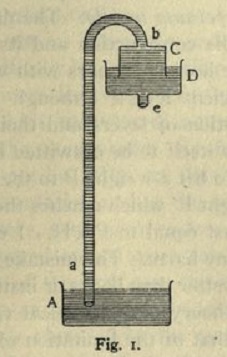
One of the constructions of the old gentleman I remember very distinctly. It may be easily understood as presented in Fig. 1. A siphon ab dips into the vessel A and at the other end with a bell-shaped expansion C into the vessel D. If the openings a and e are left unobstructed then, according to the expectation of the inventor, the small mass of water in the tube ab would follow the large masses of C and D and flow out at e. Instead of this, Cba behaved like a normal siphon flowing in the direction indicated by the letters, whereas a part of the water in D, to be sure, descended through e so that a break occurred between the water in C and in D, whereat the arrangement had failed to perform its function.
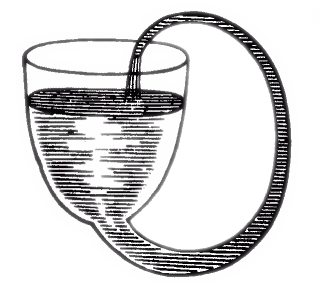
The collection of constructions of perpetual motion machines preserved in the Technical Museum at Munich must be very instructive from a psychological point of view, as far as they can be deciphered. When I was a boy I had heard so much about perpetual motion that at a time when I had only a very superficial knowledge of the law of the lever I zealously set to work on the construction of a perpetuum mobile. The drawing in Fig. 2 will make clear the construction and its error.
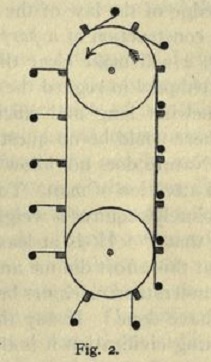
I was tempted to regard the horizontal bars with weights as somewhat long and efficient levers, although in this case there could be no question of levers and their rotation. Nature does not allow itself to be outwitted like the limited attention of man. To lift a weight P to the height H absolutely requires a weight P′ which reaches the depth H′, so that P′×H′ is at least equal to P×H.
I cannot say that this effort did me any harm. The mistake taught me to understand machines better than books or instruction could have done. If any theory is of practical value in promoting civilization it is that of the limitation of available mechanical power, and no illusion is more harmful to progress than the idea of its inexhaustibility. (Indeed one of the greatest advances made in natural science rests upon the overthrow of this illusion through a fundamental employment of it. )

One of the most remarkable inventors whom I have ever known was an old mechanic. At every detail he noted some advantage in construction and at once applied his idea. He reformed the handles and shape of beer glasses, laundry mangles, theater curtains ; he constructed a clock from a barometer-tube closed at both ends in which a short column of mercury was placed at the side of a scale marked off empirically to measure time. He was a funny old fellow who wished to do away with the figures on the tower clock because "anyone would be a fool who would not be able to tell the time by the position of the hands." He was a born physicist.
From his simple story I cannot doubt that by blowing away the sawdust from a circular saw with perforations in the rim he discovered of his own accord the principle of the disk-shaped siren and the law of tone vibrations. He was as extremely jealous of Cagniard Latour as if the latter, by his much earlier observation, had robbed him of the finest discovery.
[Mach, who spent nearly three decades in Prague, is describing Josef Romuald Božek (1814-1899), clock-maker and inventor of the curious musical instrument described below.]
On the principle of the disk-siren he based his invention of a new musical instrument which he called a sirenophone. By means of a weight and a continuous cord, a pedal set the system of the siren-disks in uniform rotation and at the same time worked a bellows. Piano keys, sunk more or less deeply with increased pressure, opened one or more tubes which blew with varying degrees of strength into the series of holes of the siren-disks so as to swell individual tones. The difference in pitch was obtained by the proportion of the radii of the pulleys over which the cords of the disks were drawn.
This instrument made far more pleasant music than a harmonium, and it would be simply impossible for it to get out of tune. It could be manufactured in perfect tune by a simple method of stamping. When a young man proposed to the inventor to sell his invention but keep its name, he received the answer, "The invention is great but unsalable." Hence he apparently preferred that it continue its existence as unique and legendary rather than be a source of profit. When a colleague once tried to play the instrument, the inventor fell upon him furiously and declared it was a sacrilege.

The inventor surrounded himself with the mystery of a medieval wizard and conjurer. The orders of the minor petty German princes for whom he had arranged various theatrical details he wore with ostentation and listed them carefully upon his visiting cards. This man's vanity greatly diminished the impression of his very considerable talent and disturbed his relations with his hardly less gifted brother.
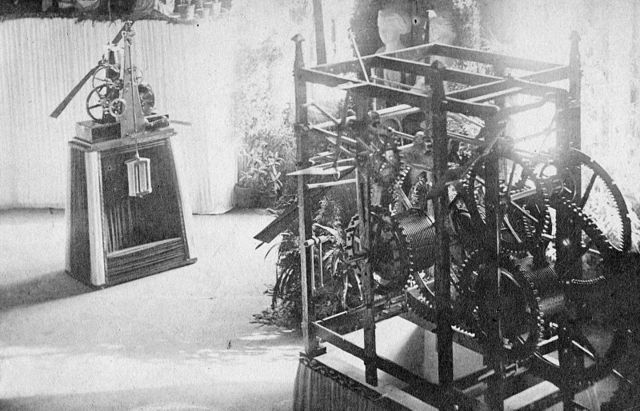
In my institute I once had a very gifted young man, D---, ...
[Mach had several assistants whose names began with "D"; I regret not knowing which one is meant. My guess would be that D--- is Vinko Dvořák, who became a prominent experimental physicist and rector of the University of Zagreb.]
In my institute I once had a very gifted young man, D---, to whom I proposed that he carry on a piece of work in physiological optics in which he made good progress. One day I came to him with the question, "Well, what are you doing?" "Nothing," was the answer, "because I haven't any pasteboard to make a new disk." "Well, if that is all it takes to put a stop to your research you will not get very far," was my reply.
This episode would not have remained in my memory if D--- had not reminded me of it years later. But it is noteworthy that soon afterwards he completed a series of fine tasks for which he had provided himself with all necessary devices in the simplest way possible; he almost never had need for anything from the materials of the institute. He constructed a Jamin compensator by cutting a slightly curved optical lens.
(I must add that I have seen many similar accessories in the collection left by Nörrenberg in Tübingen. There stood whole cases full of the cleverest optical apparatus made out of cork and glass. Nörrenberg let the endowment lapse and made his apparatus himself in order not to have to write everything down in the inventory book and keep a strict account of it. Every curator of an institution is familiar with this burden which always intrudes upon his most convenient time for work, or on his vacation.)
The young man D---, who was the exact opposite of the preceding one in seriousness and simplicity, soon became my assistant and left with me a cheerful memory of his dry humor.

When I was demonstrating to beginners the interference bands of the sodium flame by the greater thickness of layers of air of the Newton glass and bade them not to focus their eyes upon the flame but on the glass, they did not all succeed in this at once. With averted face the assistant scattered a few grains of salt over the glass, with the words, "There now, look at the salt !"
When I pointed out the Talbot bands by covering half of the pupil with a piece of mica, many looked through the mica and many looked past it. The assistant cut a small hole in a piece of black paste board and covered the half with mica, saying: "There now, look through the hole!"
When I called attention to the range of oscillation of a string which vibrated the fundamental tone and the octave at the same time, one of the class was almost misled into considering it two strings. "Put your finger in between quick, then you will have two !" said the assistant.

In this brief review we have not drawn any sharp distinction between inventors and thinkers, between invention and discovery. Indeed there is no great difference. The liberation from a practical discomfort by a new procedure we call an invention. But if we feel an intellectual discomfort, in that, for instance, we cannot follow in our thought an unaccustomed fact and cannot see through it, then we call a serviceable guide of our thoughts which helps us to do so a discovery.
When a man fiinds he cannot boil water in a pumpkin shell because it catches fire, he invents the pot by surrounding the pumpkin with clay. When a man cannot understand the light and dark bands in conflicting rays of light from two identical sources because he thinks of light as a uniform stream, he discovers interference from the instruction to represent light with periodically changing properties.
Discoveries and inventions may be due to an accidental occasional observation, as is shown in the above examples. In other cases they may be the result of prolonged systematic work as has been illuminatingly presented by the Muscovite engineer P. K. v. Engelmeyer in his essay Der Dreiakt als Lehre von der Technik und der Erfindung (Berlin, Heymann, 1910). If an invention is to be made there must be the desire to remove an inconvenience ; there must be the knowledge of the means by which this can be done, and the ability to make a practical application of them. This is the Dreiakt of the purpose, the plan for attaining it and the material performance which takes place mutatis mutandis also whenever a theoretical problem is put to a practical application.
ERNST MACH.
VIENNA, AUSTRIA.
